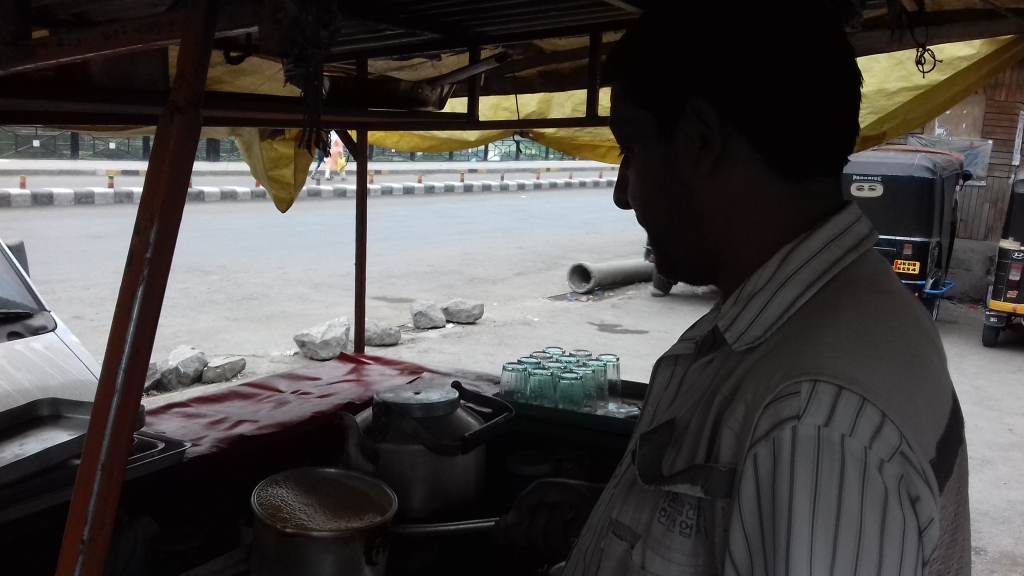This is the fifth and concluding part of an EmpireDiaries.com special series on the Kashmir valley on the occasion of the first anniversary of the scrapping of Article 370. You can the read the first, second, third and fourth parts here.
 Ratna
Ratna
Srinagar: Downtown Srinagar looked like a completely different world one month into the lockdown of Kashmir after Article 370 was scrapped in August last year.
My two team members and I used all our persuasive skills to convince an autorickshaw driver to take us around town. The plan was to go to Lal Chowk, the nerve centre of Srinagar, which was bang in the middle of the lockdown map.
Also Read: Kashmir Revisited: Losing the local economy
The purring of the autorickshaw shattering the silence of the uneasy morning, we soon found ourselves entering Lal Chowk where the famed Ghanta Ghar (clock tower) is located.

The ‘chowk’ or square expectedly wore a deserted look. The only humans that could be seen were security personnel. I took my camera out and started to record videos of the Ghanta Ghar’s surroundings and shuttered shops, when an armed security officer walked up to me.
I paused recording and took my camera down.
“What are you recording? Where are you from? Which media company?” the security officer asked a flurry of questions in a low but slightly annoyed voice.
“I am a tourist. I am not from any media,” I said, guessing that he would still sense I had something to do with the press.
“Put your camera away, please. Don’t shoot for too long, or we will have to take it away,” he said.
At that moment, our autorickshaw driver stepped in, sensing tension. “Yeh log ghumne ke liye aaye hai (They’re here to travel),” he amicably told the serviceman.
“Is this a time to travel?” the security officer asked me in an imploring tone.
“But we heard that everything is normal here,” I insisted.
“What are you getting to see here?” he retorted, trying to stress the pointlessness of touring Kashmir in times of a lockdown.
He continued in a cautionary tone, “What you see from the outside is not normal, it only seems like normal. Suggest you leave this place at once. Things are not normal here.”
The conversation ended there. We left the place in the autorickshaw.

It was 7.30 in the morning. On the way back to our hotel, we decided to stop for a tea break. We looked around and couldn’t find anything until suddenly the eureka moment arrived – we managed to locate a tiny roadside tea shack on the way from BB Cantonment area towards Dal Gate.
Also Read: Kashmir Revisited: Landing In No Man’s Land
As we ordered tea, we said hello to a few men hanging around. No sooner did we start chatting up with them that they began lamenting the unwelcome state of their lives.
The tea shop owner, a lanky and jolly chap who himself makes for a compelling story, had opened his business after 29 long days. Nearby, a man was dusting his car. He said he hadn’t taken it out for a month.

Rashid, a local seller of woolies and shawls, was sitting on the stairs of his shuttered shop, which was next to the tea joint. He goes there every morning, sits in front of his closed shop, reads two to three newspapers, then goes back home.
Also Read: Kashmir Revisited: One Year On
Rashid hadn’t been able to open his shop for business since August 5 last year when the lockdown began. Venting his ire over his business suffering, he said, “This is not new for us. We have been struggling since 1947. My grandfather struggled. My father struggled. Now I am struggling. My sons and daughters will struggle. This lockdown is not new. It has been happening here for years. You know, when Burhan Wani was killed, we had a lockdown here that lasted about six months. We are habituated to this misfortune. That’s why, Kashmiri people, you will find, have this habit of storing ration for months.”

As Rashid poured his heart out, the stories he shared with us kept us hooked as we finished a couple of rounds of steaming hot tea.
Compelling stories of Kashmir that are told orally are everlasting, meander down the valley’s streets, its mosques, its hills and its lakes. And Kashmiri people like to verbally chronicle them and pass them on.
“The reality that people outside aren’t aware of is that there are times when we end up building a strange relationship with the security personnel posted here,” according to Waleed (name changed), a Srinagar local. “They are doing their job, after all. We understand that. There are times when they become friends with us. We chat at length. We learn from them that they come here for duty from faraway places, staying away from home month after month, year after year. There have been instances when the locals have informed the forces upon learning that militants are looking for a hideout in their neighbourhood.”
The youngster recalled a hilarious story passed down to him through the local oral history network, himself laughing aloud before narrating the tale.
Also Read: ’44 Years From Now, Human Population Will Start Shrinking’
“It so happened,” he said, “That a militant gate-crashed into the modest house of a poor old man to take shelter. The old man was petrified and ready to do anything to please him. Soon after taking shelter, the militant went to the washroom for a bath. Angry at not finding shampoo, he ordered the old man to run to the local market and get a shampoo. The man, who himself had never in his life used or bought shampoo, meekly went to a local grocery store. When he asked for a bottle of shampoo, the shop owner got suspicious because he knew the old man too well – he would never buy shampoo, and besides, he appeared a little tense. Sensing that something was wrong, the shopkeeper reported the matter to CRPF personnel posted nearby, who immediately showed up at the old man’s house – only to find a militant inside the washroom! He was arrested right there.”
The restive Kashmir valley is a treasure chest of such stories.
During that Srinagar trip, if the days seemed strange, the nights were even stranger.

During the five nights I spent there, I would hear strange noises coming from the otherwise silent lane in front of the hotel. I would try to catch the activities from a corner of my window with the lights of the hotel room turned off. Diagonally opposite to the hotel was a military camp. I could see military trucks entering the narrow lane in the middle of the night, sometimes dropping off troops. At other times, jeeps could be seen taking people to the camp.
So many unanswered questions – who were those people who were being taken to the camp? The camp site was bang in the middle of a residential neighbourhood. What about the people who originally lived in that place? Was all that a ‘normal’ Kashmir? The valley was not the right place to ask too many questions during those sensitive times.
Also Read: Pandemic Turns India Into A New Hunger Hotspot
On a lighter note, I used to pull the leg of our hotel owner’s assistant, who was doubling as the cook. He had lined up the same menu – roti, daal and ‘kaddu’ (white pumpkin) curry – for all the days that we stayed there. I used to grill him, saying if those were the only dishes he ever learnt to cook, and he would profusely apologise, saying ‘kaddu’ is all that he has access to in these difficult times.
So one day when I once again asked him about the night’s menu, expecting to hear him say the dreaded word ‘kaddu’, he finally gave up explaining, saying in a resigning tone, “Phir wohi, kaddu (Same thing, what else – ‘kaddu’)”
I was only being playful with him, though. We happily lapped up what was served and we were glad that the hotel guys took the risk of letting us stay informally when all other hotels were closed for visitors.

The Kashmir valley has been witnessing the most brutal and violent conflicts ever since militancy exploded onto the scene in 1989. The geopolitical tussle to win possession of the precious land has been bloody and lengthy. For Kashmiris, the new normal keeps changing with the changing times. From where the restive valley stands today, normalcy seems like a distant dream – if not an impossible one.
Is Iran really a threat to global peace as the western world wants us to believe?
Did you know that over 97% of women in Iran are literate?
Did you know that from Ranbir Kapoor to Sridevi, Iranians are crazy about Bollywood?
Get Secret Notes From Iran for the ground report from the Persian land.








